IK Pegasi is a binary system located approximately 154 light-years away in the northern constellation Pegasus. With an apparent magnitude of 6.08, it is faintly visible to the unaided eye in exceptionally good conditions. The secondary component in the system, a white dwarf (IK Pegasi B), is the nearest supernova candidate to the Sun.
Star system
IK Pegasi is a single-line spectroscopic binary star system composed of a variable main sequence star of the spectral type kA6hA9mF0 and a massive white dwarf companion with the stellar classification DA. The two components orbit each other with a period of 21.7 days at an average distance of 0.21 astronomical units (31 million kilometres or 19 million miles), which is less than the orbit of Mercury around the Sun.
The individual components form a spectroscopic binary system and cannot be resolved. The binarity of the system can only be detected in the absorption line shift, created when the stars’ orbital motion takes them toward us and away from us, producing a doppler shift in the spectral lines.
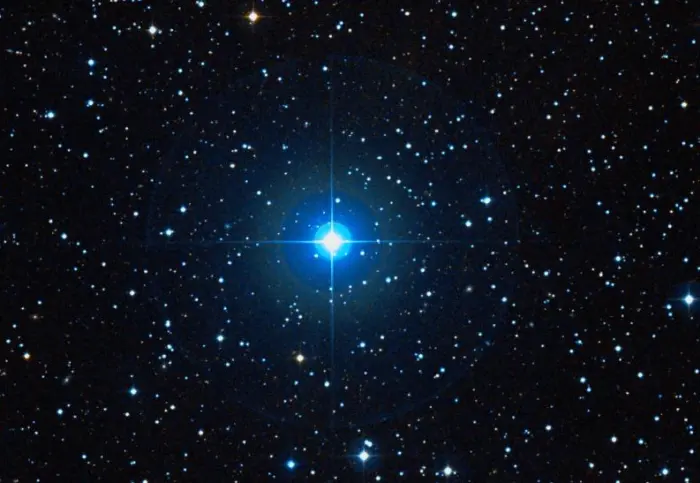
IK Pegasi, image: Wikisky (DSS2)
The distance of 150 light-years is derived from high precision measurement of the system’s parallax by the Hipparcos spacecraft.
IK Pegasi A, the primary component in the IK Pegasi system, has a mass of 1.65 solar masses and a radius of 1.47 solar radii. With an effective temperature of 7,624 K, it is 6.568 times more luminous than the Sun. The star spins at up to 32.5 km/s. It has an estimated age between 50 and 600 million years.
IK Pegasi A is classified as a Delta Scuti variable. Delta Scuti stars are short-period variables that pulsate with a period between 0.025 and 0.25 days. They are young stars whose pulsation period corresponds to the brightness variation period.
Like Cepheid variables, these stars follow a period-luminosity relation in certain bands and are used as standard candles to establish distances to deep sky objects. Other bright stars in this class include the prototype Delta Scuti in the constellation Scutum, Vega in Lyra, Altair in Aquila, Denebola in Leo, Seginus in Boötes, and Epsilon Cephei in Cepheus.
IK Pegasi shows minor luminosity variations that repeat themselves around 22.9 times per day. It has a pulsation rate of 0.044 days.
The star’s spectrum is classified as marginal Am. Am stars (metallic-line stars) are chemically peculiar stars with strong and typically variable absorption lines of metals line strontium, zinc, barium, and zirconium. At the same time, they show an underabundance of elements like calcium and scandium. IK Pegasi A has calcium and scandium abundances similar to the Sun and slightly enhanced barium and strontium lines, which may indicate mass transfer from the white dwarf progenitor star when the two components shared a common envelope.
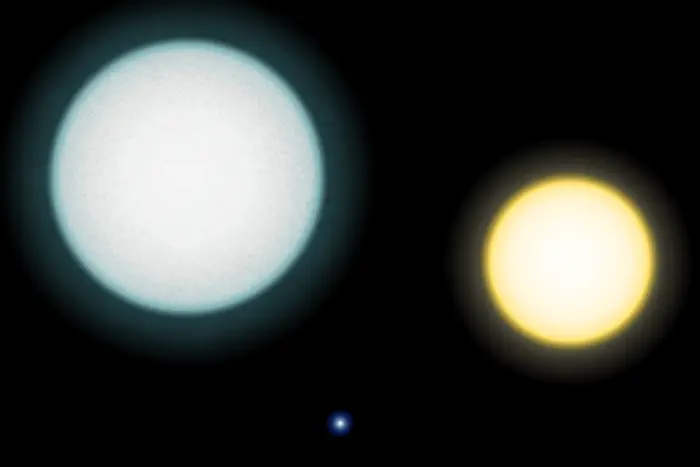
This graphic shows the relative dimensions of IK Pegasi A (left), IK Pegasi B (lower center) and the Sun. Image: Wikimedia Commons/RJHall (CC BY-SA 3.0)
IK Pegasi B, the dense white dwarf companion star, packs a mass of 1.15 solar masses into a radius of only 0.006 solar radii, comparable to the volume of the Earth. The stellar remnant has a strong surface gravity – 8.95 cgs (centimetre-gram-seconds) – which is more than 900,000 times the Earth’s gravitational force (2.99 cgs).
The white dwarf shines with 12% of the Sun’s luminosity and has a surface temperature of 35,500 K. The high effective temperature makes the remnant a strong ultraviolet source.
The interior of IK Pegasi B is either composed of carbon and oxygen or oxygen and neon. The surface of the white dwarf is covered by a hydrogen-rich atmosphere, indicated by the spectral type DA.
IK Pegasi B evolved faster than the component A because it was once the more massive of the two stars. Astronomers believe it had a mass of 5 to 8 solar masses when it was on the main sequence. The star burned through its supply of hydrogen fuel faster due to its high mass and, after expanding into a red giant, it expelled its outer layers to form a planetary nebula. When it was on the asymptotic giant branch (AGB), it may have expanded to several hundred times the radius of the Sun. At this point, the two components of IK Peg likely shared a common envelope.
The core remnant of IK Peg B, the white dwarf, would ordinarily continue to cool and fade for billions of years. However, because it is part of a close binary system, it may have a more dramatic fate.
Supernova
IK Pegasi B is the nearest known supernova progenitor candidate to the solar system. When the primary component reaches the end of its life and stops fusing hydrogen into helium, it will begin to expand into a red giant. At a certain point, the white dwarf star will begin to accrete matter from its companion’s gaseous envelope.
As the giant expands, its outer gaseous envelope will overflow the white dwarf’s Roche lobe, producing an accretion disk around the remnant. The gas – mostly hydrogen and helium – in the accretion disk will be accreted onto the companion’s surface.
The transfer of mass will result in a decreased orbital distance between IK Pegasi A and B. Once IK Peg B approaches the limit of 1.4 solar masses (the Chandrasekhar limit), it will no longer be able to resist gravitational collapse through electron degeneracy pressure and it may go out as a Type Ia supernova.
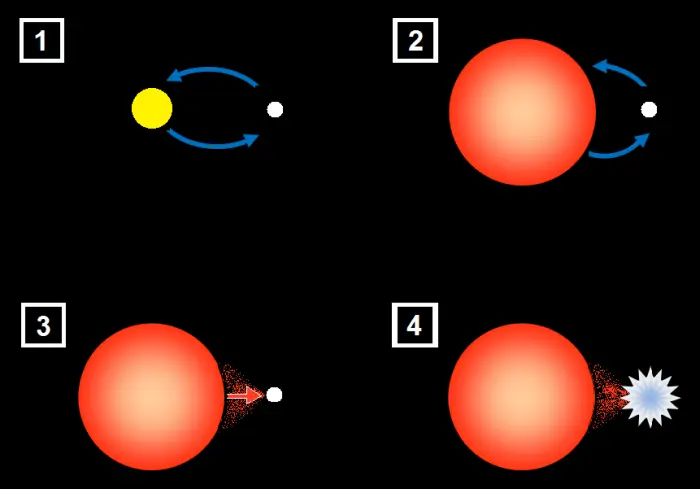
Diagram showing accretion by a binary white dwarf star, leading to a type Ia supernova, image credit: Wikimedia Commons/FT2 (CC0 1.0)
If the white dwarf’s core is composed of neon, oxygen and magnesium, the remnant will probably become a neutron star and only some of its mass will be expelled. However, if IK Peg B has a carbon-oxygen core, the runaway nuclear fusion reaction will consume a significant part of the remnant.
IK Pegasi A has a main sequence lifetime of 2-3 x 109 years (2-3 billion years). With an estimated age of 50 – 600 million years, it will not begin to evolve into a giant any time soon. Astronomers do not expect IK Pegasi B to go out as a supernova for another 1.9 billion years.
By the time the primary component expands, the star system will have moved to a greater distance from Earth. With a space velocity of 20.4 km/s relative to the Sun, it is currently moving away from the solar system at a rate one light-year every 14,700 years. In 5 million years, IK Pegasi will be over 500 light-years away. While Type Ia supernovae may affect Earth from as far as 3,300 light-years (1,000 parsecs) away, to significantly harm the Earth’s biosphere, they would need to occur within about 30 light-years (10 parsecs).
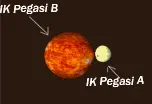
Animation of the formation of binary star IK Pegasi, image credit: European Southern Observatory (ESO) (PD)
Alternatively, IK Pegasi B may become a recurrent nova like RS Ophiuchi, T Pyxidis or T Coronae Borealis. The nova events would result from the accreted gas on the white dwarf’s surface becoming heated and compressed, and triggering a runaway reaction that would eject some of the gas from the remnant’s surface. Nova events typically increase the luminosity of a white dwarf by several magnitudes over shorter periods (days or months).
If IK Pegasi B continues to accumulate mass from its companion without erupting, it may become a close-binary supersoft X-ray source (CBSS). Super soft X-rays are thought to be the product of steady nuclear fusion of material pulled from the companion on the surface of a white dwarf. The fusion requires a high flow of material. Super soft X-ray sources can produce Type Ia supernovae if the white dwarf is destroyed by a sudden fusion of material.
Facts
Located at a distance of 154 light-years (47.3 parsecs), IK Pegasi is the nearest known supernova candidate to the Sun. Other supernova progenitor candidates within 300 parsecs include Spica in the constellation Virgo (250 ly, 77 pc), Acrux A and B in Crux (320 ly, 99 pc), Zeta Ophiuchi in Ophiuchus (440 ly, 130 pc), Alpha Lupi in Lupus (460 ly, 142 pc), Betelgeuse in Orion (408 – 548 ly, 125 – 168.1 pc), Antares in Scorpius (550 ly, 170 pc), Pi Puppis in Puppis (810 ly, 250 pc), and Rigel in Orion (848 ly, 260 pc).
The orbital period of 21.724 for the IK Pegasi system was measured by the Canadian astronomer William E. Harper in 1927. A more accurate period of 21.72168 ± 0.00009 days was obtained during observations with the EUVE space telescope in the late 1990s.
In 2000, astronomers attempted to resolve IK Pegasi A and B and 16 other binary systems using the Wide Field and Planetary Camera 2 aboard the Hubble Space Telescope (HST). However, they were unable to photograph the individual components because the stars are too close together.
Name
IK Pegasi does not have a traditional name or a proper name approved by the International Astronomical Union (IAU). It is commonly referred to by its variable star designation IK Pegasi.
The star is listed as HD 204188 in the Henry Draper Catalogue, and HIP 105860 in the Hipparcos catalogue. It was listed as BD +18°4794B in the 1862 Bonn Durchmusterung (Bonn astrometric survey) and HR 8210 in the Harvard Revised Photometry Catalogue (now the Yale Catalogue of Bright Stars), first published by the Harvard College Observatory (HCO) under the supervision of Edward Charles Pickering in 1884.
Location
IK Pegasi lies roughly halfway between the Great Square of Pegasus, formed by Alpheratz, Scheat, Markab and Algenib, and Altair in the constellation Aquila. The star lies a little more than halfway from Alshain, the fainter of the two stars flanking Altair, to Scheat in the Great Square of Pegasus.
IK Pegasi appears near the imaginary line connecting Enif, the brightest star in Pegasus, and Aljanah at the wing of the celestial Swan (Cygnus). The constellation figure of Delphinus points in its general direction. The brighter triple star system 1 Pegasi appears in the same field of view.

The location of IK Pegasi, image: Stellarium
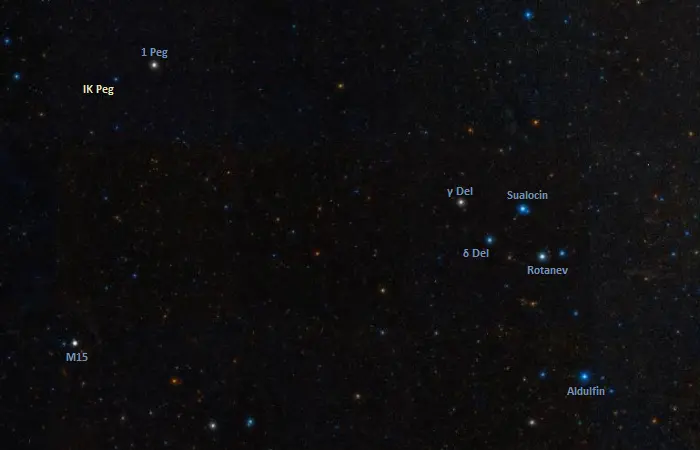
IK Pegasi, 1 Pegasi and the constellation Delphinus, image: Wikisky (DSS2)
Constellation
IK Pegasi is located in the constellation Pegasus. The celestial Winged Horse is the seventh largest constellation in the sky, stretching across 1,121 square degrees. In Greek mythology, the constellation is associated with Pegasus, the offspring of the sea god Poseidon and the Gorgon Medusa.
Pegasus is one of the Greek constellations, catalogued by the Greek astronomer Claudius Ptolemy of Alexandria in his mathematical and astronomical treatise Mathēmatikḕ Sýntaxis (Μαθηματικὴ Σύνταξις), which later became known as the Almagest. The Almagest was written around 150 CE.
Pegasus is one of the most recognizable constellations in the northern celestial hemisphere. It is dominated by a bright, large asterism called the Great Square of Pegasus, formed by Scheat (Beta Pegasi), Markab (Alpha Pegasi), and Algenib (Gamma Pegasi) in Pegasus with the brighter Alpheratz (Alpha Andromedae) in the neighbouring constellation Andromeda.
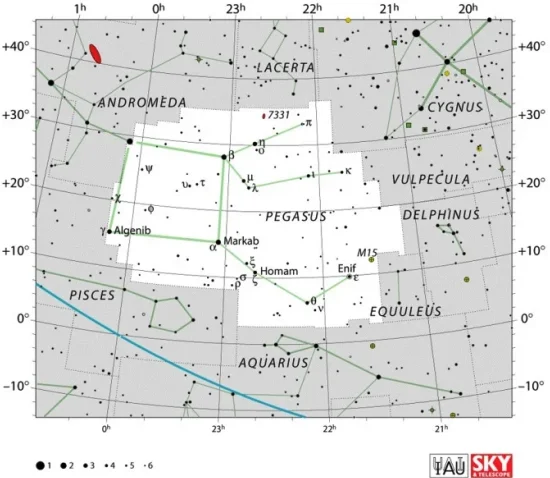
Pegasus constellation map by IAU and Sky&Telescope magazine (Roger Sinnott & Rick Fienberg) (CC BY 3.0)
With five stars brighter than magnitude 3.0, Pegasus is visible even from areas with some light-pollution. The constellation’s brightest star, the orange supergiant Enif, shines at magnitude 2.399 from a distance of 690 light-years.
Most of the bright stars in Pegasus have evolved away from the main sequence. Other than Enif, they include the hot blue supernova candidate Algenib (Gamma Pegasi), the red giant or bright giant Scheat (Beta Pegasi), the A-type subgiant Markab (Alpha Pegasi), the yellow bright giant Matar (Eta Pegasi), the yellow giant Sadalbari (Mu Pegasi), the yellow giant or bright giant Lambda Pegasi, and the F-type giant Alkarab (Upsilon Pegasi).
Other notable stars in Pegasus include the hot blue main sequence star Homam (Zeta Pegasi), the fast-spinning A-type star Biham (Theta Pegasi), the Sun-like star Helvetios (51 Pegasi), which hosts the first extrasolar planet discovered orbiting a main sequence star, and the chemically peculiar variable star HR 8799, which hosts four orbiting exoplanets.
Pegasus contains several relatively bright deep sky objects. These include the Great Pegasus Cluster (Messier 15, NGC 7078), a globular cluster visible in binoculars, the barred spiral galaxy NGC 7479 (the Superman Galaxy), the unbarred spiral galaxy NGC 7331 and the Deer Lick Group (NGC 7331 Group), the unbarred spiral NGC 7217, the spiral galaxy NGC 7742 (the Fried Egg Galaxy), and the interacting galaxies NGC 7752 and NGC 7753 and NGC 7469 and IC 5283.
The constellation is also home to the gravitationally lensed quasar known as the Einstein Cross and the visual grouping HCG 92 (Hickson Compact Group 92), popularly known as Stephan’s Quintet.
The best time of the year to observe the stars and deep sky objects in Pegasus is during the month of October, when the constellation appears higher above the horizon in the early evening. The entire constellation is visible from locations north of the latitude 60° S.
The 10 brightest stars in Pegasus are Enif (Epsilon Peg, mag. 2.399), Scheat (Beta Peg, mag. 2.42), Markab (Alpha Peg, mag. 2.48), Algenib (Gamma Peg, mag. 2.84), Matar (Eta Peg, mag. 2.95), Homam (Zeta Peg, mag. 3.414), Sadalbari (Mu Peg, mag. 3.514), Biham (Theta Peg, mag. 3.52), Iota Pegasi (mag. 3.77), and Lambda Pegasi (mag. 3.93).
IK Pegasi
| Spectral class | kA6hA9mF0 or A8m: + DA |
| Variable type (IK Peg A) | Delta Scuti |
| U-B colour index (IK Peg A) | 0.03 |
| B-V colour index (IK Peg A) | 0.235 ± 0.009 |
| Apparent magnitude | 6.08 |
| Absolute magnitude | 2.75 |
| Distance | 154 ± 1 light-years (47.3 ± 0.3 parsecs) |
| Parallax | 21.6789 ± 0.139 mas |
| Radial velocity | −9.7 ± 0.2 km/s |
| Proper motion | RA: +80.499 ± 0.174 mas/yr |
| Dec.: +16.657 ± 0.105 mas/yr | |
| Constellation | Pegasus |
| Right ascension | 21h 26m 26.6611049976s |
| Declination | +19° 22′ 32.310190344″ |
| Names and designations | IK Pegasi, HD 204188, HR 8210, HIP 105860, SAO 107138, BD+18° 4794, AG+19 2186, GC 30023, GCRV 13485, PPM 140137, GSC 01671-00710, AGKR 19171, SBC7 857, SBC9 1307, YZ 19 8745, EUVE J2126+19.3, 2EUVE J2126+19.3, WEB 19199, N30 4732, Renson 56880, TD1 28097, TIC 283235463, RE J2126+192, RE J212626+192257, 2RE J2126+192, 2RE J212626+192300, RX J2126.4+1922, 1RXS J212626.8+192224, 2MASS J21262666+1922323, WD 2124+191, TYC 1671-710-1, Gaia DR1 1787127782968262400, Gaia DR2 1787127787263968640, Gaia DR3 1787127787263968640 |
IK Pegasi A
| Mass | 1.65 M☉ |
| Luminosity | 6.568 ± 0.051 L☉ |
| Radius | 1.47 R☉ (1.38 – 1.54 R☉) |
| Temperature | 7,624 K (7,443 – 7861 K) |
| Metallicity | 117 |
| Age | 50 – 600 million years |
| Rotational velocity | < 32.5 km/s |
| Surface gravity | 4.25 cgs |
IK Pegasi B
| Mass | 1.15 M☉ |
| Luminosity | 0.12 L☉ |
| Radius | 0.006 R☉ |
| Temperature | 35,500 K |
| Surface gravity | 8.95 cgs |